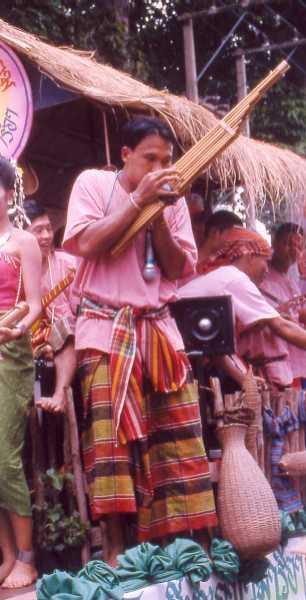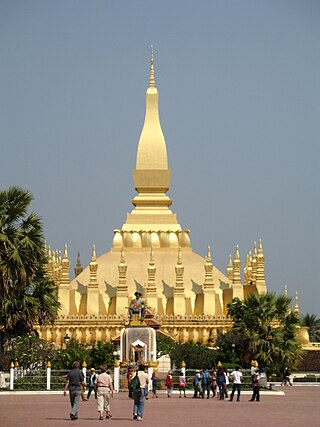Related Research Articles

Laos, officially the Lao People's Democratic Republic (LPDR), is the only landlocked country in Southeast Asia. It is bordered by Myanmar and China to the northwest, Vietnam to the east, Cambodia to the southeast, and Thailand to the west and southwest. Its capital and most populous city is Vientiane.

Luang Phabang, or Louangphabang, commonly transliterated into Western languages from the pre-1975 Lao spelling ຫຼວງພຣະບາງ as Luang Prabang, literally meaning "Royal Buddha Image", is a city in north central Laos, consisting of 58 adjacent villages, of which 33 comprise the UNESCO Town of Luang Prabang World Heritage Site. It was listed in 1995 for unique and "remarkably" well preserved architectural, religious and cultural heritage, a blend of the rural and urban developments over several centuries, including the French colonial influences during the 19th and 20th centuries.

Prince Souvanna Phouma was the leader of the neutralist faction and Prime Minister of the Kingdom of Laos several times.

The khaen is a Lao mouth organ whose pipes, which are usually made of bamboo, are connected with a small, hollowed-out hardwood reservoir into which air is blown. The khene is the national instrument of Laos. The khene music is an integral part of Lao life that promotes family and social cohesion and it was inscribed in 2017 on the UNESCO Representative List of the Intangible Cultural Heritage of Humanity. It is used among the ethnic Lao Isan and Some tai ethnic groups such as Tai dam In north Vietnam and Lao population of the province of Stung Treng and is used in lakhon ken, a Cambodian dance drama genre that features the khene as the main instrument In Vietnam, this instrument is used among the Tai peoples and the Muong people.

Laab / Larb is a type of Lao meat salad that is the national dish of Laos, along with green papaya salad and sticky rice. Laab in the Lao language is a noun that refers to meat or other flesh that has been finely chopped and pounded. It is also considered a food of good luck in both Laos and Thailand because it has homonyms that mean 'lucky' in both languages, derived from लाभ in Sanskrit. Laab is of Lao origin, but is also eaten in other regions, most prominently the neighboring former Lan Xang territory, or modern day Laos and the northeastern and northern areas of Thailand, Isan and Lanna where the Lao have extended their influence. Other local variants of laab also feature in the cuisines of the Tai peoples of Shan State, Burma, and Yunnan Province, China.

The president of the Lao People's Democratic Republic is the head of state of Laos. The current president is Thongloun Sisoulith, since 22 March 2021. He was previously elected as the General Secretary of the Lao People's Revolutionary Party, Laos' most powerful position in January 2021, ranking him first in the Politburo.

Theravada Buddhism is the largest religion in Laos, which is practiced by 66% of the population. Lao Buddhism is a unique version of Theravada Buddhism and is at the basis of ethnic Lao culture. Buddhism in Laos is often closely tied to animist beliefs and belief in ancestral spirits, particularly in rural areas.
Laotian Canadians, are Canadian citizens of Laotian origin or descent. In the 2016 Census, 24,580 people indicated Laotian ancestry. Bilateral relations between Canada and Laos were established in 1954 with the formalization of the independence of the Kingdom of Laos from France. In August 2015, Canada's first resident diplomat opened the Office of the Embassy of Canada in Vientiane, Laos.

Lao-Lao is a Laotian rice whisky produced in Laos. Along with Beerlao, lao-Lao is a staple drink in Laos.

The French protectorate of Laos was a French protectorate in Southeast Asia of what is today Laos between 1893 and 1953—with a brief interregnum as a Japanese puppet state in 1945—which constituted part of French Indochina. It was established over the Siamese vassal, the Kingdom of Luang Phrabang, following the Franco-Siamese crisis of 1893. It was integrated into French Indochina and in the following years further Siamese vassals, the Principality of Phuan and Kingdom of Champasak, were annexed into it in 1899 and 1904, respectively.
The Laotian Chinese are Laotian citizens of Han Chinese ancestry. They constitute one of the many Overseas Chinese residing in Southeast Asia. At present, they constitute an estimated 1 to 2 percent of the Laotian population. The Laotian Chinese community have a disproportionately large presence in the Laotian business sector and dominate the Laotian economy today.

Chinese-Laotian relations refers to the current and historical relationship between Lao People's Democratic Republic and the People's Republic of China.

Vientiane is the capital and largest city of Laos. Comprising the five urban districts of Vientiane Prefecture, the city is located on the banks of the Mekong, right at the border with Thailand. Vientiane was the administrative capital during French rule and, due to economic growth in recent times, is now the economic center of Laos. The city had a population of 840,000 as of the 2023 Census.

Khao poon ; also known as Lao royal vermicelli curry soup or Lao laksa and sometimes spelled kapoon, khao poun or khao pun) is a popular national noodle soup of Laos. Khao poon is one type of Lao rice vermicelli soup that is often made with pounded chicken, fish, or pork in coconut milk broth and seasoned with common Lao ingredients such as fish sauce, padaek, lime leaves, galangal, garlic, shallots, Lao chillies, and fish mint. Different versions of the dish are also in Malaysia, Thailand, Indonesia, Cambodia, Singapore, and the United States.

The Kingdom of Luang Phrabang, also called Kingdom of Luang Prabang was formed in 1707 as a result of the split of the Kingdom of Lan Xang. When the kingdom split, Muang Phuan became a tributary state of Luang Prabang. Over the years the monarchy weakened even more, and was forced to become a vassal various times to the Burmese and the Siamese monarchies.

Vientiane province is a province of Laos in the country's northwest. As of 2015 the province had a population of 419,090. Vientiane province covers an area of 15,610 square kilometres (6,030 sq mi) composed of 11 districts. The principal towns are Vang Vieng and Muang Phôn-Hông.

Savannakhet is a province of Laos. The name derives from Savanh Nakhone the province's original name. It bears the same meaning as Nakhon Sawan, a city in Thailand.

Luang Prabang is a province in northern Laos. Its capital of the same name, Luang Prabang, was the capital of the Lan Xang Kingdom during the 13th to 16th centuries. It is listed since 1995 by UNESCO as a World Heritage Site for unique architectural, religious and cultural heritage, a blend of the rural and urban developments over several centuries, including the French colonial influences during the 19th and 20th centuries. The province has 12 districts. The Royal Palace, the national museum in the capital city, and the Phou Loei Protected Reserve are important sites. Notable temples in the province are the Wat Xieng Thong, Wat Wisunarat, Wat Sen, Wat Xieng Muan, and Wat Manorom. The Lao New Year is celebrated in April as The Bun Pi Mai.
The Laotian diaspora consists of roughly 800,000 people, both descendants of early emigrants from Laos, as well as more recent refugees who escaped the country following its communist takeover as a result of the Laotian Civil War. The overwhelming majority of overseas Laotians live in just three countries: Thailand, the United States, and France.
References
- ↑ Simms, Sanda (2013-10-11). The Kingdoms of Laos. Routledge. ISBN 978-1-136-86330-1.
- ↑ Souk-Aloun, Phou-ngeun (2002-01-01). HISTOIRE DU LAOS MODERNE (1930-2000) (in French). Editions L'Harmattan. ISBN 978-2-296-29988-7.